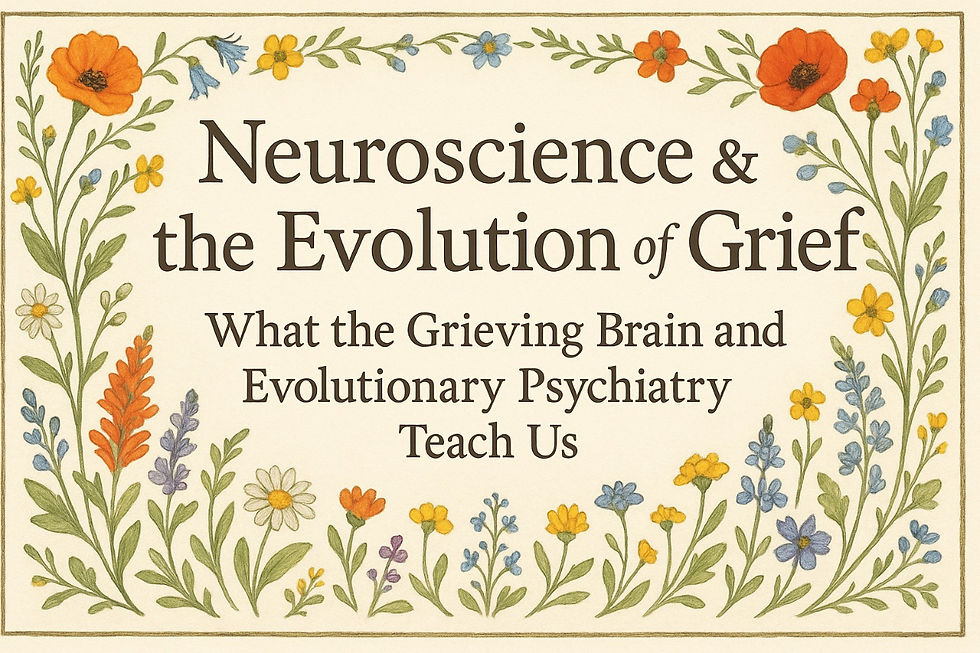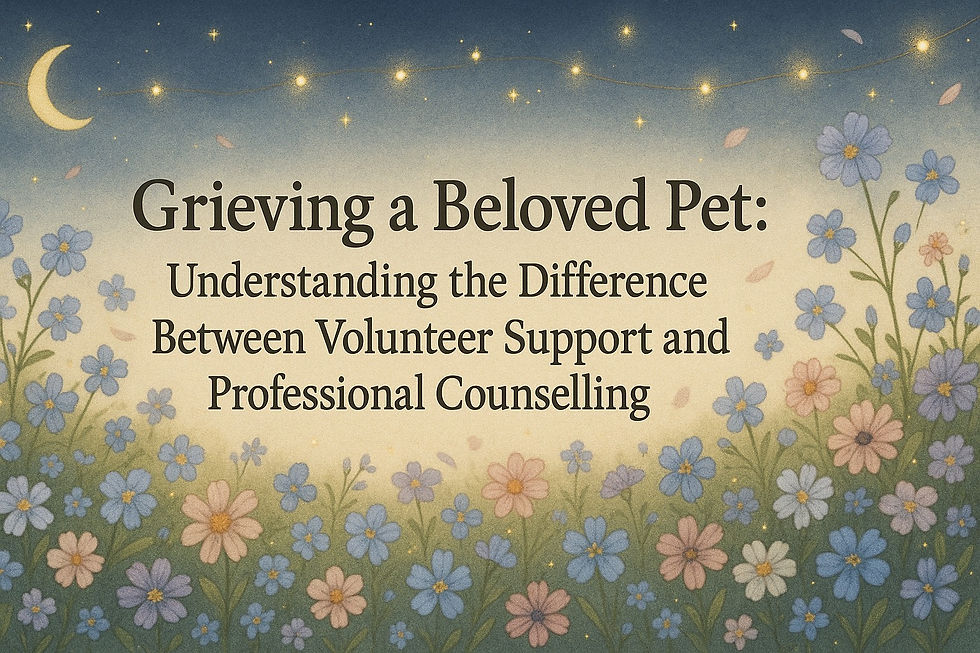Neuroscience & the Evolution of Grief: What the Grieving Brain and Evolutionary Psychiatry Teach Us
- Andy

- Jun 25
- 4 min read

One of the seven “healing milestones” in bereavement counselling is recognised to be psychoeducation. Psychoeducation empowers individuals and provides them with the understanding that the therapeutic methods applied will be effective. When people are equipped with knowledge about what they are experiencing, they often feel less isolated and more validated in their emotions. This understanding can significantly reduce feelings of confusion and helplessness, which are common during periods of mourning. Furthermore, psychoeducation helps to demystify the grieving process, allowing individuals to recognize that their feelings, whether they be sadness, anger, guilt, or even relief, are all natural responses to loss. This acknowledgment can foster a sense of agency, encouraging individuals to actively engage in their healing journey.
In the below article I draw particularly upon three of my favourite books in the field of grief, mental health & wellbeing: Mary Frances O’Connor’s “The Grieving Brain”; Randolph Nesse’s “Good reasons for bad feelings”; and Paul M Martin’s “Personal Grief Rituals”.
Grief is often described as a storm of emotion — but neuroscience and evolutionary psychiatry suggest it’s also a deeply structured biological and cognitive response. Through the lens of evolutionary theory, grief may be seen as an adaptive process rooted in attachment, while neuroscientific research, particularly the work of Dr. Mary-Frances
O’Connor, reveals how the brain processes loss and why it can be so difficult to accept the death of someone we love.
Together, these perspectives offer a powerful and compassionate framework for understanding why grief feels the way it does — and why it takes time to heal.
Grief & the Attachment System: How we evolved to seek closeness and where we see this in the brain
From an evolutionary psychiatry standpoint, grief is a by product of the attachment system — the same system that bonds infants to caregivers, and adults to close companions. Attachment helped our ancestors survive in dangerous environments by promoting closeness, protection, and cooperation.
According to Dr. O’Connor, our brains develop a mental model — or “neural representation” — of our loved ones. This model helps us predict where they are, what they would say or do, and how they fit into our daily lives. When someone dies, that neural representation doesn’t vanish immediately. Instead, the brain continues to expect the person
to appear, call, or walk into the room.
This discrepancy between expectation and reality is what causes the intense confusion and emotional pain of early grief. The brain must gradually update its internal model to reflect the person’s absence — a process that takes time and effort, both cognitively and emotionally.
The Brain in Grief: Key Regions Involved
Dr. O’Connor’s neuroimaging research has shown that grief activates specific regions in the brain:
The nucleus accumbens, a brain region involved in reward and longing, is often active when people experience yearning for a lost loved one. This may help explain why grief can feel physically painful and emotionally craving — similar to addiction.
The anterior cingulate cortex and insula, which process social pain and emotional awareness, are also active during grief —especially when processing reminders of the deceased.
The default mode network, which is engaged in memory and self-referential thinking, often shows increased activity in grieving individuals. This suggests that grief is not just emotional — it’s also about narrative, identity, and personal meaning.
These systems were likely evolutionarily conserved to maintain bonds critical to survival — and the distress signals when those bonds are broken may have served a social function, alerting others to help the grieving individual.
Prolonged Grief and the Brain: When Updating Fails
In most people, the brain slowly updates its model of the world to incorporate the reality of the loss — not forgetting the loved one, but recognizing they are no longer physically present. However, in Prolonged Grief Disorder (PGD), this updating process seems to stall.
Dr. O’Connor has observed that in prolonged grief:
The nucleus accumbens remains hyperactive, suggesting persistent yearning.
The brain may struggle to resolve the conflict between wanting reunion and knowing reunion is impossible.
Individuals continue to behave — emotionally and cognitively — as if the deceased might still return.
From an evolutionary standpoint, this could reflect a mismatch between our ancient neural systems and modern realities — especially in a culture that lacks shared grieving rituals, clear timelines, and consistent support.
Continuing Bonds: A Bridge Between Memory and Meaning
Rather than letting go completely, grieving individuals often maintain continuing bonds — an ongoing inner connection to the deceased. Neuroscience supports this: remembering the deceased activates memory and attachment regions, and can bring comfort, not just pain.
Healthy continuing bonds might involve:
Revisiting memories with warmth instead of raw longing
Talking to or about the deceased as a source of guidance
Living in alignment with the values or legacy of the loved one
Dr. O’Connor and others argue that these bonds can help the brain integrate loss, creating a new narrative that includes the past relationship while allowing space for the future.
Conclusion: Grief as a Rewiring of the Self
Grief is not a passive state — it's an active process of brain-based relearning, identity reconstruction, and emotional recalibration. Evolution gave us the capacity to bond deeply, and as Dr. Mary-Frances O’Connor’s work shows, the brain must work hard to accept when those bonds are irreversibly changed.
Understanding grief through the lens of both neuroscience and evolution allows us to approach it not as a weakness or pathology, but as a natural- even necessary - expression of love, memory, and adaptation.

.png)





Comments